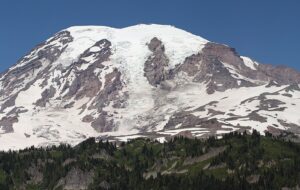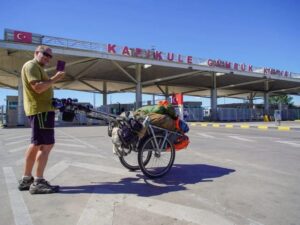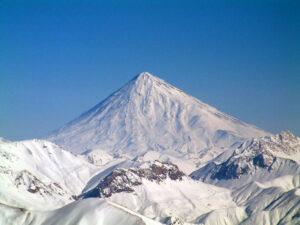As 2022 dawned, more than 100,000 Russian troops were stationed on three sides of Ukraine. Russian escalation in the long-running conflict with Ukraine seemed imminent, although many thought that Vladimir Putin was saber-rattling. Then on February 24, Russian troops descended on the country.
Against the buildup to this chaos, a young Ukrainian soldier, Alina Kosovska, had planned a long wilderness trek in the dead of winter. On January 8, Kosovska set off from the village of Velyky Berezny, in northern Ukraine. On her back was a hefty pack, stuffed to the brim with food and gear. Ahead lay over a month of solo hiking in midwinter on Ukraine’s Transcarpathian Route. A 400km trail that takes the highest and most challenging sections of the Carpathian Mountains that lie within Ukraine.

In uniform in April 2022. Kosovska has been a career soldier since 2015. Photo: Alina Kosovska
A lesser-known trail
Unlike established trails such as the Appalachian Trail in the United States, the Transcarpathian Route is underdeveloped, with few outside visitors. Although not brimming with technical peaks, the route is wild, remote, and a significant challenge for a solo hiker in winter.
Undeterred, Kosovska, whipped herself into shape by running marathons. She also tested her key pieces of equipment in winter conditions, where reliability matters far more than during warmer seasons.

Sunset over the Carpathian National Nature Park, Ukraine. Photo: Shutterstock
The Ukrainian soldier donned snowshoes and initially headed north, before looping south in the direction of the Romanian border. The burden of a heavy pack worsened when snow conditions became tricky. In the deep, soft forest snow, Kosovska found the going tough. She slowed down to less than 1 kph in places.
“There is a lot of snow there,” she said. “It is not covered with an ice crust and it is difficult and long to walk on it, especially uphill.”

Kosovska had to deal with soft snow in forested areas. Photo: Alina Kosovska
Pushing through the slow days
At ExplorersWeb we cover a whole range of winter expeditions, from Antarctic sledding to winter treks in North America. When the pace slows and days of slogging through deep snow pile up, the only thing to do is to grind on. Quite often, we see adventurers fail, sometimes through a lack of experience in these conditions, and other times due to an unwillingness to ride out the monotony.
Kosovska’s average pace was 1.5kph, and her longest day was 12 hours. Undeterred the Ukrainian soldier pushed on without faltering.

Goofing around on the trail. Photo: Alina Kosovska
Every 20 to 60km, Kosovska had the opportunity to restock her mobile pantry at villages en route, although this depended on the area. On one section through the Chornohora range, which included climbing Hoverla, Ukraine’s highest peak (2,061m), the determined mountaineer had to push 100km without resupply.
“It is the most difficult because you have to walk almost 100km carrying all food, fuel, and supplies.”

A bluebird day high in the mountains. Photo: Alina Kosovska
Dropping off medical supplies
As well as collecting supplies, Kosovska made use of shepherd huts as a break from camping. There are typically three types of huts in the Ukrainian mountains: kolybas, where cheese dairies operate in summer, hunting cabins, and tourist shelters.
As in many parts of the world, there is a tradition to leave dry firewood, supplies, and medicine for future travelers. Kosovska took it upon herself to leave first aid kits in each of the huts she visited.

Dropping off fresh medical supplies. Photo: Alina Kosovska
Few people are known to have attempted this route in winter, and these attempts are not well documented. Although navigational markings are reasonable in summer, the route Kosovska followed is less clear under a winter blanket. This also makes it more technically challenging.
However, Kosovska is the director of a charitable foundation and volunteer mountaineering group and guides tourists in the Carpathians when on military leave. This experience of the same mountains in summer no doubt helped her through the trickier sections.

Lunch after summiting Turkul (1,933m) in the Chornohora range of the Carpathian Mountains in western Ukraine. Photo: Alina Kosovska
A return to service
After 37 days of snowshoeing, covering some 400km, Kosovska arrived at the end of the trail in Dilove, near the Romanian border. It was February 14, just 10 days before the invasion. She had just completed the first known winter crossing of Ukraine’s Transcarpathian Route. She did it the hard way — solo, in the coldest months, and against the backdrop of war.

Kosovska’s route. Credit: 4Sport.ua
Since finishing the trek, Kosovska resumed her military role as a drone operator in aerial reconnaissance.
Despite some leave to guide in the mountains in the past month, she will be heading back to the front lines in January. “I have been doing this since 2015 and will continue to do it as long as necessary,” says the resolute young Ukrainian.

Kosovska at work as a drone operator. Photo: Alina Kosovska






